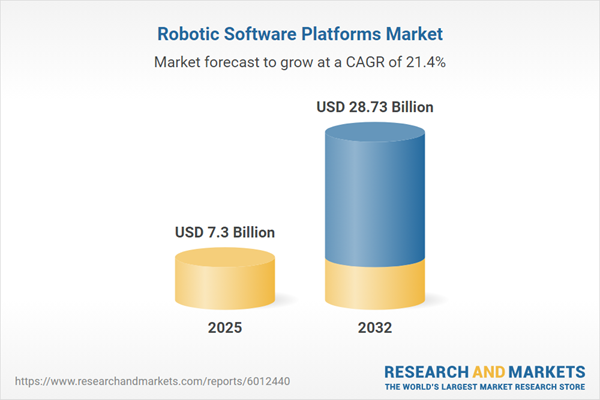Speak directly to the analyst to clarify any post sales queries you may have.
Robotic software platforms are rapidly becoming the backbone of next-generation automation. Senior leaders are increasingly evaluating these platforms as strategic enablers for operational agility, improved safety, and accelerated innovation across both established and emerging sectors.
Market Snapshot: Robotic Software Platforms Market Size and Trajectory
The Robotic Software Platforms Market grew from USD 6.07 billion in 2024 to USD 7.30 billion in 2025. It is expected to continue growing at a CAGR of 21.43%, reaching USD 28.73 billion by 2032. This sharp market expansion highlights the increasing priority that organizations place on software-driven robotics solutions to address scaling complexities, speed up deployment, and support advanced automation goals.
Scope & Segmentation of the Robotic Software Platforms Market
This report provides a thorough examination of the market through several essential segmentations and key regions:
- Software Type: AI & Machine Learning-based Software, Middleware Software, Motion Control Software, Robotic Operating System (ROS) Software, Simulators, Vision Processing Software.
- Robot Type: Autonomous Mobile Robots (AMRs), Collaborative Robots (Cobots), Humanoid Robots, Industrial Robots, Specialized Robots.
- Deployment Type: Cloud-Based, On-Premise.
- Organization Size: Large Enterprises, Small & Medium Enterprises (SMEs).
- Vertical: Aerospace & Defense, Agriculture, Automotive, Energy & Utilities, Healthcare, Manufacturing, Retail.
- Region: Americas (United States, Canada, Mexico, Brazil, Argentina, Chile, Colombia, Peru), Europe, Middle East & Africa (United Kingdom, Germany, France, Russia, Italy, Spain, Netherlands, Sweden, Poland, Switzerland, United Arab Emirates, Saudi Arabia, Qatar, Turkey, Israel, South Africa, Nigeria, Egypt, Kenya), Asia-Pacific (China, India, Japan, Australia, South Korea, Indonesia, Thailand, Malaysia, Singapore, Taiwan).
- Company Coverage: ABB Ltd., Aibrain Inc., Amazon Web Services, Inc., Anduril Industries, Boston Dynamics, Brain Corporation, Clearpath Robotics, CloudMinds Technology, Inc., Cyberbotics Ltd., Dassault Systemes, Energy Robotics, FANUC Corporation, FPT Software Ltd., International Business Machines Corporation, iRobot Corporation, KEBA, Microsoft Corporation, Neurala, Inc., NVIDIA Corporation, Rockwell Automation Inc., Teradyne, Inc., Universal Robots AS, Yaskawa Electric Corporation.
Key Takeaways for Senior Decision-Makers
- Cutting-edge robotic software platforms now integrate middleware, real-time control, and advanced algorithms to drive interoperability and efficiency across robotic applications.
- Unified frameworks combining AI vision, simulation, and motion control enable seamless management from design to deployment, reducing development cycles and system complexity.
- The adoption of cloud-native architectures broadens access to global collaboration, accelerates testing, and optimizes performance through advanced analytics.
- Standardized operating systems and open-source initiatives reduce fragmentation, increase flexibility, and encourage robust ecosystems for third-party modules and plugins.
- Strategic focus on both modular and scalable solutions supports diverse application needs, allowing organizations to tailor platforms for manufacturing, logistics, healthcare, and beyond.
Tariff Impact: Navigating US Tariffs and Supply Chain Adjustments
With new US tariffs on key electronic components imposed in 2025, global robotics software vendors face intensified pricing pressure and increased operational costs. In response, the industry is moving to diversify supply chains, adopt onshore assembly, and partner with domestic manufacturers. Many providers are reengineering software stacks for broader hardware compatibility, supporting agility amid shifting trade circumstances. This disruption is prompting innovation as firms decouple proprietary algorithms from specific hardware, positioning for both cost efficiency and emerging nearshore opportunities.
Methodology & Data Sources
This report blends primary research—such as direct interviews with robotics executives, integrators, and engineers—with secondary analysis of peer-reviewed publications, white papers, and corporate disclosures. Triangulation ensures validation of quantitative insights, while qualitative trends are synthesized through thematic analysis and expert consultations across key regions and industry associations.
Why This Report Matters for Technology and Operations Leaders
- Equips decision-makers with actionable segmentation and regional analysis to support precise strategic planning and successful market entry or expansion.
- Outlines the impact of evolving technology, regulatory shifts, and emerging business models on platform adoption and operational resilience.
- Delivers clarity for aligning product development, supply chain choices, and partnership strategies with pressing industry trends and competitive imperatives.
Conclusion
Robotic software platforms are reshaping automated operations across industries. With a robust understanding of market segmentation, regulatory context, and key technology shifts, organizations can position for sustainable growth and enduring competitive advantage in this evolving landscape.
Additional Product Information:
- Purchase of this report includes 1 year online access with quarterly updates.
- This report can be updated on request. Please contact our Customer Experience team using the Ask a Question widget on our website.
Table of Contents
3. Executive Summary
4. Market Overview
7. Cumulative Impact of Artificial Intelligence 2025
Companies Mentioned
The companies profiled in this Robotic Software Platforms market report include:- ABB Ltd.
- Aibrain Inc.
- Amazon Web Services, Inc.
- Anduril Industries
- Boston Dynamics
- Brain Corporation
- Clearpath Robotics
- CloudMinds Technology, Inc.
- Cyberbotics Ltd.
- Dassault Systemes
- Energy Robotics
- FANUC Corporation
- FPT Software Ltd.
- International Business Machines Corporation
- iRobot Corporation
- KEBA
- Microsoft Corporation
- Neurala, Inc.
- NVIDIA Corporation
- Rockwell Automation Inc.
- Teradyne, Inc.
- Universal Robots AS
- Yaskawa Electric Corporation
Table Information
| Report Attribute | Details |
|---|---|
| No. of Pages | 197 |
| Published | November 2025 |
| Forecast Period | 2025 - 2032 |
| Estimated Market Value ( USD | $ 7.3 Billion |
| Forecasted Market Value ( USD | $ 28.73 Billion |
| Compound Annual Growth Rate | 21.4% |
| Regions Covered | Global |
| No. of Companies Mentioned | 24 |









